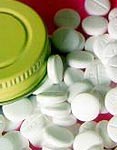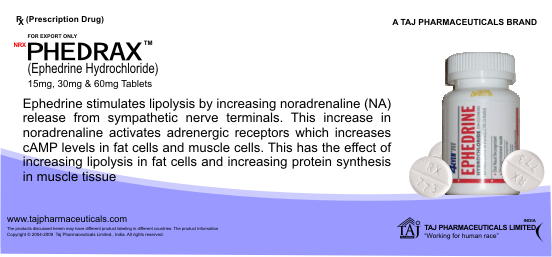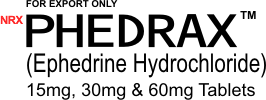|
|
 Ephedrine stimulates lipolysis by increasing noradrenaline
(NA) release from sympathetic nerve terminals. This increase in
noradrenaline activates adrenergic receptors which increases cAMP
levels in fat cells and muscle cells. This has the effect of
increasing lipolysis in fat cells and increasing protein synthesis
in muscle tissue. Negative feedback mechanisms are activated as
well, and involve the production of phosphodiesterases, adenosine,
and prostaglandins. Caffeine has the ability to inhibit
phosphodiesterase activity and interfere with the adenosine
receptor. This combined with its ability to prevent some NA
re-uptake12 increase the effectiveness of ephedrine in a
synergistic fashion. Aspirin has been shown to increase the
effectiveness of ephedrine in some individuals presumably by its
actions as a prostaglandin inhibitor. Ephedrine stimulates lipolysis by increasing noradrenaline
(NA) release from sympathetic nerve terminals. This increase in
noradrenaline activates adrenergic receptors which increases cAMP
levels in fat cells and muscle cells. This has the effect of
increasing lipolysis in fat cells and increasing protein synthesis
in muscle tissue. Negative feedback mechanisms are activated as
well, and involve the production of phosphodiesterases, adenosine,
and prostaglandins. Caffeine has the ability to inhibit
phosphodiesterase activity and interfere with the adenosine
receptor. This combined with its ability to prevent some NA
re-uptake12 increase the effectiveness of ephedrine in a
synergistic fashion. Aspirin has been shown to increase the
effectiveness of ephedrine in some individuals presumably by its
actions as a prostaglandin inhibitor.
Maximum effectiveness is achieved when taking 20 mg ephedrine with
200 mg caffeine and 300 mg aspirin three times a day about one
half hour before meals. Common side effects are associated with
its sympathetic activity namely, anorexia, initial rise in blood
pressure, initial tachycardia, slowed GI motility (constipation),
insomnia, agitation, anxiety, nervousness and depression- like
withdrawal symptoms. Most all of these symptoms exhibit
tachyphylaxis after about 4-6 weeks. Thermogenic activity seems to
last upwards of 20 weeks due to its low desensitization properties
and beta-3 affinity. About 75% of ephedrine’s effects on weight
loss in the obese are due to appetite control.
Anyone considering taking ephedrine, caffeine and aspirin should
educated themselves first about the potential side effects.
Individuals with pre-existing high blood pressure should not use
sympathomimetics such as ephedrine. When taking herbal forms of
ephedrine, be sure you understand just how much is in each
serving. Be aware that herbal preparations are standardized but
you still can not be sure exactly how much you are taking with
each capsule.
GENERAL DESCRIPTION & APPLICATIONS
Ephedrine is a sympathomimetic alkaloid originally obtained from
species of Ephedra or prepared synthetically. Its action is
similar to that of epinephrine (a catecholamine hormone secreted
by the adrenal medulla and a neurotransmitter). Its effects,
although less powerful, are more prolonged, and it exerts action
when administered orally, whereas epinephrine is effective only by
injection. It is used as muscle relaxants, central nervous system
and cardiac muscle stimulants in combination with others like
theophylline. It is used to prevent hypotension during spinal and
infiltration anesthesia; and as a mydriatic. There are enantiomers
in ephedrine structure. (1R,2S)- and (1S,2R)-enantiomers are
designated ephedrine (opposite stereoisomerisms around the chiral
center), whereas (1R,2R)- and (1S,2S)-enantiomers are designated
pseudoephedrine. Commercial ephedrine is (-)-(1R,2S)-ephedrine
[also called (-)-Ephedrine or L-ephedrine], while commercial
pseudoephedrine enantiomer is (1S,2S)-pseudoephedrine [(+)-pseudoephedrine
or D-pseudoephedrine]. Pseudoephedrine has less pressor action and
fewer central stimulant effects than ephedrine. Pseudoephedrine is
used as a nasal decongestant and a bronchodilator to relaxe and
open the air passages to the lung to increase the flow of air, and
thus is used in the treatment and/or prevention of symptoms of
bronchial asthma and of reversible bronchospasm associated with
chronic bronchitis and emphysema.

Ephedrine stimulates lipolysis by increasing noradrenaline
(NA) release from sympathetic nerve terminals. This increase in
noradrenaline activates adrenergic receptors which increases cAMP
levels in fat cells and muscle cells. This has the effect of
increasing lipolysis in fat cells and increasing protein synthesis
in muscle tissue. Negative feedback mechanisms are activated as
well, and involve the production of phosphodiesterases, adenosine,
and prostaglandins. Caffeine has the ability to inhibit
phosphodiesterase activity and interfere with the adenosine
receptor. This combined with its ability to prevent some NA
re-uptake12 increase the effectiveness of ephedrine in a
synergistic fashion. Aspirin has been shown to increase the
effectiveness of ephedrine in some individuals presumably by its
actions as a prostaglandin inhibitor.
Maximum effectiveness is achieved when taking 20 mg ephedrine with
200 mg caffeine and 300 mg aspirin three times a day about one
half hour before meals. Common side effects are associated with
its sympathetic activity namely, anorexia, initial rise in blood
pressure, initial tachycardia, slowed GI motility (constipation),
insomnia, agitation, anxiety, nervousness and depression- like
withdrawal symptoms. Most all of these symptoms exhibit
tachyphylaxis after about 4-6 weeks. Thermogenic activity seems to
last upwards of 20 weeks due to its low desensitization properties
and beta-3 affinity. About 75% of ephedrine’s effects on weight
loss in the obese are due to appetite control.
Anyone considering taking ephedrine, caffeine and aspirin should
educated themselves first about the potential side effects.
Individuals with pre-existing high blood pressure should not use
sympathomimetics such as ephedrine. When taking herbal forms of
ephedrine, be sure you understand just how much is in each
serving. Be aware that herbal preparations are standardized but
you still can not be sure exactly how much you are taking with
each capsule.
Presentation
Phedrax Tablets
Strip of 20 Tablets
|
|




 Ephedrine stimulates lipolysis by increasing noradrenaline
(NA) release from sympathetic nerve terminals. This increase in
noradrenaline activates adrenergic receptors which increases cAMP
levels in fat cells and muscle cells. This has the effect of
increasing lipolysis in fat cells and increasing protein synthesis
in muscle tissue. Negative feedback mechanisms are activated as
well, and involve the production of phosphodiesterases, adenosine,
and prostaglandins. Caffeine has the ability to inhibit
phosphodiesterase activity and interfere with the adenosine
receptor. This combined with its ability to prevent some NA
re-uptake12 increase the effectiveness of ephedrine in a
synergistic fashion. Aspirin has been shown to increase the
effectiveness of ephedrine in some individuals presumably by its
actions as a prostaglandin inhibitor.
Ephedrine stimulates lipolysis by increasing noradrenaline
(NA) release from sympathetic nerve terminals. This increase in
noradrenaline activates adrenergic receptors which increases cAMP
levels in fat cells and muscle cells. This has the effect of
increasing lipolysis in fat cells and increasing protein synthesis
in muscle tissue. Negative feedback mechanisms are activated as
well, and involve the production of phosphodiesterases, adenosine,
and prostaglandins. Caffeine has the ability to inhibit
phosphodiesterase activity and interfere with the adenosine
receptor. This combined with its ability to prevent some NA
re-uptake12 increase the effectiveness of ephedrine in a
synergistic fashion. Aspirin has been shown to increase the
effectiveness of ephedrine in some individuals presumably by its
actions as a prostaglandin inhibitor.
